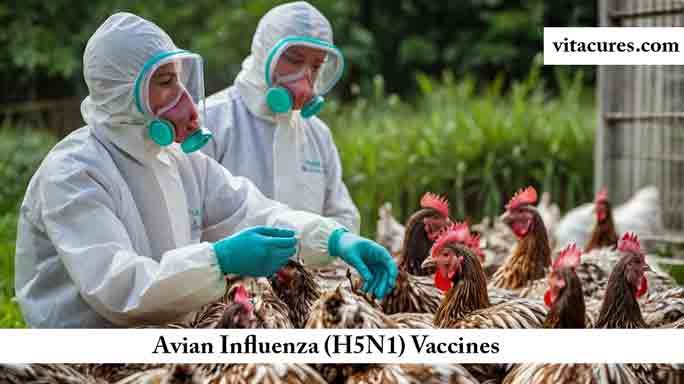Avian Influenza: Imagine waking up to headlines about a virus that threatens both our feathered friends and potentially our own health. Avian Influenza, commonly known as bird flu, specifically the H5N1 strain, has been a concern for years.
But what about vaccines? Are they effective? Are they available? What does their status mean for you and your family? You deserve clarity on this pressing issue. Understanding the current status of H5N1 vaccines is not just about keeping up with global health trends; it’s about ensuring safety for yourself and your loved ones.
This information empowers you to make informed decisions and helps you understand the efforts to curb a virus that could affect us all. Dive into the details, and discover what you need to know about the fight against Avian Influenza. This knowledge is your tool for peace of mind. Let’s explore the status of H5N1 vaccines together, and see what it means for your world.

Avian Influenza: An Overview
Avian Influenza, often called bird flu, is a viral infection. It primarily affects birds but can impact humans too. The H5N1 strain is particularly dangerous. The disease spreads quickly among birds, causing severe illness and death. Understanding this virus is crucial for controlling outbreaks.
H5n1 Virus Characteristics
The H5N1 virus is a subtype of the influenza A virus. It is highly pathogenic in birds. This means it causes severe disease. The virus can survive in cool environments for long periods. It spreads through direct contact with infected birds. Contaminated surfaces can also harbor the virus. In humans, H5N1 is rare but deadly.
Impact On Poultry And Humans
H5N1 has a devastating effect on poultry farms. The virus spreads rapidly, leading to large-scale culling of birds. This results in significant economic losses for farmers. For humans, the impact is severe if contracted. The mortality rate is high, around 60%. Human cases occur mostly in people who handle infected birds.
Effective vaccines are crucial for both birds and humans. They help control the spread and impact of the virus. Research is ongoing to develop better vaccines. Understanding H5N1 is key to preventing future outbreaks.
Vaccine Development Challenges
The development of vaccines for Avian Influenza (H5N1) poses significant challenges. Scientists face complex hurdles that impact the speed and effectiveness of vaccine creation. Each obstacle brings unique difficulties, requiring innovative solutions and collaboration.
Scientific And Technical Obstacles
Creating an effective H5N1 vaccine involves navigating scientific and technical complexities. One major challenge is the virus’s rapid mutation rate. This means that by the time a vaccine is developed, the virus may have evolved into a new strain.
Another hurdle is ensuring the vaccine is both safe and potent. Scientists must test various formulations to find the balance between effectiveness and safety. It’s a delicate dance of trial and error, often requiring years of dedicated research.
Have you ever wondered how scientists choose which strain to target? It’s a high-stakes decision based on predictions and patterns, similar to weather forecasting. The wrong choice could mean a vaccine that’s ineffective against the next outbreak.
Regulatory Hurdles
Beyond scientific challenges, regulatory processes also slow vaccine development. Approval requires rigorous testing and compliance with stringent regulations. Navigating this bureaucratic maze is essential to bring vaccines to market.
Regulators demand extensive safety trials before approving any vaccine. While ensuring public safety, these trials extend timelines and increase costs. This can be frustrating for researchers eager to deploy solutions quickly.
Have you ever considered the global aspect? Different countries have different regulatory standards, complicating international distribution. Harmonizing these standards is crucial for global readiness against outbreaks.
What do you think could streamline these processes? Innovative partnerships between governments and biotech companies could hold the key. With shared goals, these collaborations might fast-track crucial developments.
In tackling these challenges, you realize the importance of patience and innovation. The pathway to effective H5N1 vaccines requires overcoming hurdles both in the lab and in the regulatory arena. As you learn more, think about how you can contribute or support efforts in vaccine development. Every small action counts in the larger fight against Avian Influenza.
Current Vaccine Technologies
Avian Influenza (H5N1) poses a significant threat globally. Vaccine development is crucial to control outbreaks. Understanding current vaccine technologies offers insights into how we combat this virus.
Traditional Approaches
Traditional vaccines often use inactivated or live-attenuated virus forms. These vaccines stimulate the immune system by introducing a harmless version of the virus. The body learns to recognize and fight the real virus. These methods have been used for decades. They are effective, but production can be slow. Mass production requires specialized facilities and time.
Innovative Solutions
Modern science explores new methods like mRNA vaccines. This technology teaches cells to produce a protein that triggers immunity. Another method involves viral vector vaccines. They use a harmless virus to deliver genetic material from H5N1. These innovations promise faster production and effective responses. They are adaptable to changes in the virus, ensuring longer-lasting protection.
Global Efforts In Vaccine Research
Research continues globally to develop effective H5N1 vaccines. Scientists aim to protect against Avian Influenza outbreaks. Progress involves testing various formulas for safety and efficacy.
Global Efforts in Vaccine Research
The race to develop effective vaccines for Avian Influenza (H5N1) is a global endeavor. Countries around the world are joining forces to tackle this pressing health issue. With the virus posing a significant threat to both animal and human health, the urgency is palpable.
Governments, private sectors, and scientific communities are pooling their resources. This collaboration is vital to speed up research and ensure vaccines are safe and effective. You might wonder how these global efforts are coordinated and funded.
Let’s dive into the key aspects driving these international collaborations.
Collaborations And Partnerships
One of the most inspiring aspects of vaccine research is the global collaboration. Countries are sharing data, research findings, and resources like never before. This cooperation is crucial for overcoming geographical and financial barriers.
Organizations like the World Health Organization (WHO) and the Coalition for Epidemic Preparedness Innovations (CEPI) are at the forefront. They facilitate partnerships across continents, ensuring that progress is swift and comprehensive. Have you ever thought about the power of collective action in the scientific community?
These partnerships often involve universities, biotech companies, and government agencies working hand in hand. This synergy helps in optimizing research efforts and speeding up the development of vaccines.
Funding And Resources
Financial backing is another cornerstone of vaccine research. Adequate funding ensures that research can continue without interruption. Governments and international bodies are investing heavily in this area.
The European Union, for instance, has allocated significant funds for H5N1 vaccine research. Similarly, the United States has increased its budget for avian influenza preparedness. This commitment is crucial for maintaining momentum in vaccine development.
Private sector involvement is also key. Pharmaceutical companies are investing in research, with many entering partnerships with public institutions. Such collaborations bring not only financial resources but also technical expertise to the table.
So, what role do you think public awareness plays in attracting more funding? Awareness can drive demand for more research, influencing both public and private sectors to invest further.
Engagement from individuals and communities can lead to increased political will, which is vital for sustained funding. Your support and awareness can indirectly shape the future of these crucial vaccine developments.
Clinical Trials And Findings
The quest for effective Avian Influenza (H5N1) vaccines is a global endeavor. Clinical trials play a crucial role in determining the viability of these vaccines. They offer insights into how well a vaccine works and its safety. If you’re wondering about the current status of these trials, let’s dive into the findings and challenges faced.
Efficacy And Safety Results
Clinical trials assess how well a vaccine performs in real-world settings. Recent trials of the H5N1 vaccine have shown promising efficacy. They demonstrated a strong immune response in participants.
Safety is equally important. Trials have reported minimal side effects. These are similar to those seen with regular flu shots, such as mild fever or soreness at the injection site.
It’s encouraging to note that the vaccines are effective and safe. But what does this mean for you? It implies a step closer to protecting both humans and poultry from a potentially devastating virus.
Challenges In Trial Execution
Conducting trials for H5N1 vaccines is not without hurdles. One major challenge is ensuring enough volunteers. The fear of unknown side effects can deter participation.
Another issue is the virus’s unpredictable nature. It requires constant updates to the vaccine formula, which complicates the trial process.
Despite these challenges, researchers are committed to overcoming them. They constantly adapt and learn from each trial phase. The question arises: how can we support these efforts? Your awareness and understanding can make a difference.
Have you ever wondered what goes into the making of a vaccine? Each trial phase is a step towards understanding and combating H5N1. It’s a journey of science and dedication, and your knowledge is part of that journey.
Future Directions In Vaccine Development
The fight against Avian Influenza (H5N1) is advancing, with vaccine development taking center stage in safeguarding public health. Exciting future directions in vaccine development are emerging, promising more effective and accessible solutions. As scientists and researchers push boundaries, you might wonder how these innovations will shape our world.
Emerging Technologies
Recent advancements in technology are paving the way for groundbreaking vaccine innovations. Imagine vaccines that can be quickly tailored to combat new strains of H5N1. Techniques like mRNA technology are leading the charge, offering the ability to rapidly produce vaccines that are both safe and effective.
This approach is not just theoretical. mRNA vaccines have already proven their worth in combating COVID-19. With such technologies, the future of H5N1 vaccines could be faster and more adaptable than ever. How do you think this will change the way we respond to outbreaks?
Potential Impact On Public Health
The potential impact of these vaccines on public health is profound. Vaccines developed with emerging technologies could significantly reduce the spread of H5N1. This means fewer outbreaks and a lower risk of transmission from animals to humans.
Imagine a world where H5N1 is no longer a looming threat. Accessible and efficient vaccines could transform how we live, work, and travel. But achieving this requires investment and collaboration. What role do you see yourself playing in this global effort?
By understanding these future directions, you become part of the conversation. Your awareness can drive support for research and innovation, ultimately leading to safer communities. Are you ready to be part of this transformative journey?
Frequently Asked Questions
Are They Working On An H5n1 Vaccine?
Yes, researchers are actively developing an H5N1 vaccine. Various trials and studies are underway globally. Scientists aim to ensure safety and effectiveness. Efforts focus on preparedness against potential outbreaks. Health organizations closely monitor progress to protect public health.
Is There An Fda-approved H5n1 Vaccine?
Yes, the FDA has approved an H5N1 vaccine for emergency use. It’s intended for high-risk individuals during a pandemic. The vaccine helps protect against avian influenza, commonly known as bird flu. Consult healthcare providers for more information on availability and eligibility.
Which Companies Make H5n1 Vaccines?
Several companies produce H5N1 vaccines, including Sanofi Pasteur, GlaxoSmithKline, and Novartis. They focus on developing effective vaccines to combat avian influenza. These vaccines aim to prevent the spread of the virus and protect public health.
Is There A Vaccine For Poultry For H5n1?
Yes, a vaccine exists for poultry against the H5N1 virus. It helps prevent the spread of avian influenza. Farmers use it to protect their flocks from outbreaks. Regular vaccination is crucial for maintaining poultry health. Always consult a veterinarian for proper vaccination guidelines.
Conclusion
Avian Influenza vaccines are crucial for controlling outbreaks. They help protect birds and humans. Current vaccines show promise but need more research. Scientists work hard to improve vaccine effectiveness. Challenges exist, like virus mutations and global distribution. Yet, progress continues.
It’s important to stay informed about developments. Vaccines play a key role in preventing future pandemics. Health organizations monitor and update strategies regularly. Public awareness and cooperation are essential. Together, we can manage avian influenza risks. Stay informed. Stay safe.



